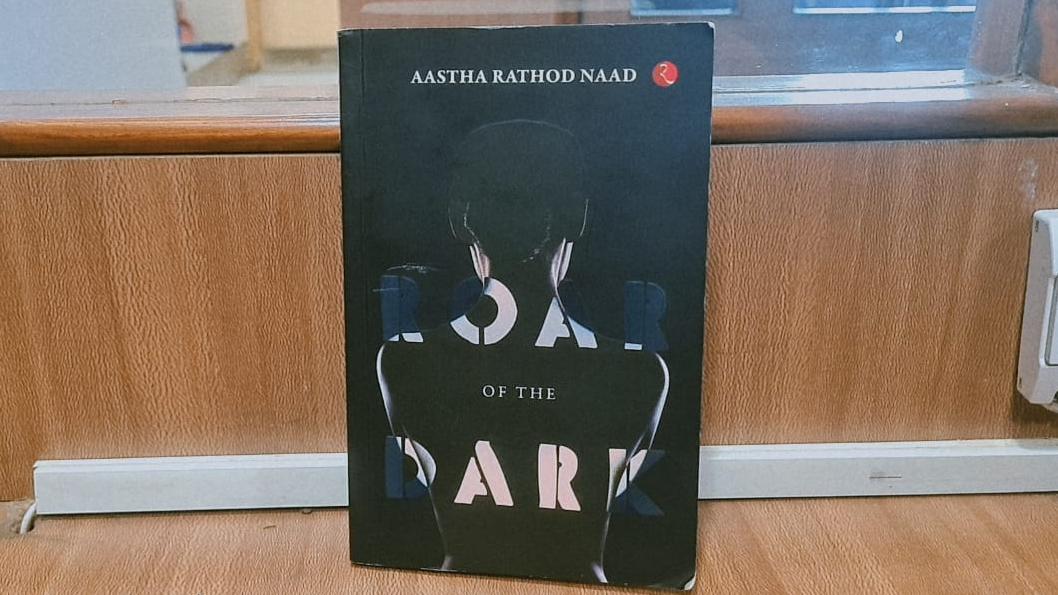Meera, a virgin, believes that it is a chaste body that can fulfil all her desires of a lasting love.
For Maheen, her body is an offering that she will gladly bestow on the feet of her husband.
Meanwhile, Joe finds power in her naked body. She considers it a tool that she could wield to her advantage.
Kalika realizes that everything has a price—product, idea, emotions, ethics and even the body.
On one unfortunate night, these four women come face to face with a brutal reality, shaking their beliefs to the core, changing their worlds forever. Aastha Rathod Naad explores women’s investment in their bodies, their conditioning to think of the body as the most precious asset in a provocative story that is a pleasure to read. Sensuous and impossible to put down, this is a masterful portrayal of desire and longing, innocence and the pull of the dark.

“Roar of the Dark” by Aastha Rathod Naad is a captivating exploration that challenges conventional ideas of femininity and female sexuality. Naad adeptly delves into the multifaceted issues that women face in their everyday lives. The author skillfully portrays the diverse struggles and perspectives of her characters, highlighting and discussing the four most common understandings that women associate with their bodies.
The narrative revolves around four women, mentioned in the blurb: Meera, Maheen, Joe, and Kalika. Each character is intricately woven into the fabric of the story, sharing their unique life experiences, values, and beliefs. However, I found that Meera’s character development, in particular, lacked depth in the initial stages of the book. It felt as though her introduction was overshadowed by other characters, only to take centre stage later on. This uneven focus disrupted the narrative flow, creating a somewhat disjointed reading experience.
I believe that better editing could have significantly enhanced the book, as I encountered several grammatical errors, particularly in the first half. Additionally, Kalika’s rapid transformation, within a few days, seemed implausible and remained unacceptable for me throughout the story. It should have happened over at least a few months, showing gradual development, to be believable.
I also believe that a discerning editor might have been able to note the lack of importance and then the sudden excess importance given to Meera compared to the other characters. Despite her noted absence and lack of information about her lifestyle in the first half, she becomes the driving point for the story in the second half as she takes the reins of her life into her own hands and chooses to narrate the tale to the world.
Joe and Maheen represent opposites in the story as both of their ideas regarding a woman’s body are different. My focus remains on how, despite these differences, they came together and became part of a single narrative.
I appreciate how the author has highlighted both the instances, the changing of a woman’s idea of her sexuality with time as well as the difficulty she faces in doing so. The author has also focused on how families, religious propaganda and our peers play an important role in our understanding of our body. And while few women can realise and alter those ideas, there exist women who can’t.
The character of Sharmila Tejwal stands out for her complexity, though I wished for more insight into her perspective on femininity and sexuality. A deeper exploration of her relationship with Meera could have added depth to both characters, fostering a stronger sense of female camaraderie. I understand that she was looking at everything from a business point of view and it wasn’t her fault if what got sold or became a bestseller was the darkness. However, I believe that when she chooses to protect Mera, we could have had a conversation between them which could have brought about a strong female friendship between the two. This would have not only given Sharmila a chance to explain her idea of sexuality as separate from business but also given us a chance to know how Meera felt about her ideal after knowing the truth and if she supported her.
Visually striking, the cover art effectively conveys the thematic significance of darkness in the narrative, though the title could be more prominent for clarity. I absolutely loved the silhouette of the woman’s body on the cover and the darkness that surrounded her. This emphasised the importance of darkness and night in the story. Interestingly, I believe that every woman would have interpreted the cover differently. The woman in it could have been believed to be shy, scared or even happy. This freedom of choice highlights the central idea of the book, how different women understand their bodies differently. My only issue with the cover was that the title was not clearly visible because of the lack of contrast. However, as I saw on Amazon, there is a high chance that the publishers have corrected this already and hence, I won’t focus on it.
Despite these shortcomings, “Roar of the Dark” skillfully navigates themes of female sexuality and identity. Naad expertly explores the influence of family, religion, and societal norms on women’s perceptions of their bodies, shedding light on both the struggle for self-realisation and the barriers that impede it.
I also hope that the author takes my request into consideration and makes a few improvements in the plot and gets the book edited better for the reprint (because yes, I can see this book becoming a best-seller, at least in my eyes). Naad’s potential as a bestselling author is evident, and I eagerly anticipate future endeavours.
I was given a review copy of the book in exchange for an honest review.
